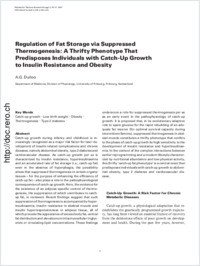Regulation of fat storage via suppressed thermogenesis: a thrifty phenotype that predisposes individuals with catch-up growth to insulin resistance and obesity
- Dulloo, Abdul G. Department of Medicine, Division of Physiology, University of Fribourg, Switzerland
-
2006
Published in:
- Hormone Research. - 2006, vol. 65, no. 3, p. 90-97
English
Catch-up growth during infancy and childhood is increasingly recognized as a major risk factor for later development of insulin-related complications and chronic diseases, namely abdominal obesity, type 2 diabetes and cardiovascular disease. As catch-up growth per se is characterized by insulin resistance, hyperinsulinaemia and an accelerated rate of fat storage (i.e., catch-up fat) even in the absence of hyperphagia, the possibility arises that suppressed thermogenesis in certain organs/tissues - for the purpose of enhancing the efficiency of catch-up fat - also plays a role in the pathophysiological consequences of catch-up growth. Here, the evidence for the existence of an adipose-specific control of thermogenesis, the suppression of which contributes to catch-up fat, is reviewed. Recent findings suggest that such suppression of thermogenesis is accompanied by hyperinsulinaemia, insulin resistance in skeletal muscle and insulin hyperresponsiveness in adipose tissue, all of which precede the appearance of excess body fat, central fat distribution and elevations in intramyocellular triglyceride or circulating lipid concentrations. These findings underscore a role for suppressed thermogenesis per se as an early event in the pathophysiology of catch-up growth. It is proposed that, in its evolutionary adaptive role to spare glucose for the rapid rebuilding of an adequate fat reserve (for optimal survival capacity during intermittent famine), suppressed thermogenesis in skeletal muscle constitutes a thrifty phenotype that confers to the phase of catch-up growth its high sensitivity to the development of insulin resistance and hyperinsulinaemia. In the context of the complex interactions between earlier reprogramming and a modern lifestyle characterized by nutritional abundance and low physical activity, this thrifty 'catch-up fat phenotype' is a central event that predisposes individuals with catch-up growth to abdominal obesity, type 2 diabetes and cardiovascular disease.
- Faculty
- Faculté des sciences et de médecine
- Department
- Département de Médecine
- Language
-
- English
- Classification
- Medicine
- License
- License undefined
- Identifiers
-
- RERO DOC 5823
- DOI 10.1159/000091512
- Persistent URL
- https://folia.unifr.ch/unifr/documents/300022
Statistics
Document views: 176
File downloads:
- dulloo_rfs.pdf: 294
